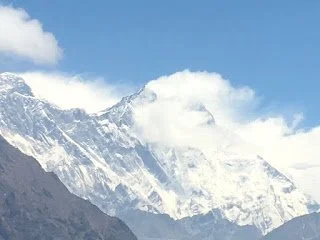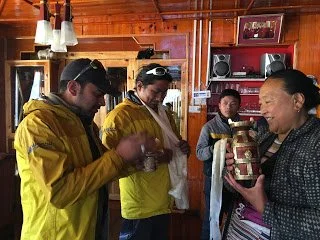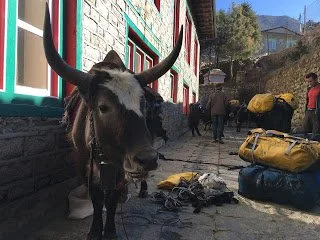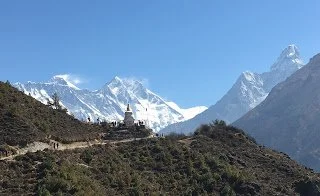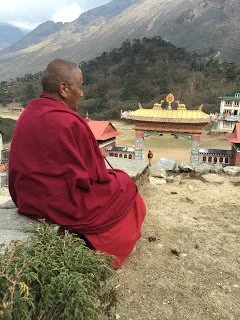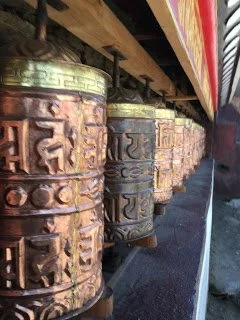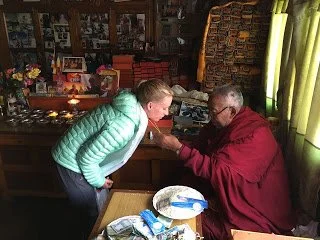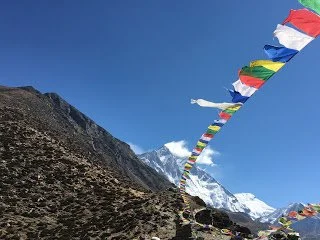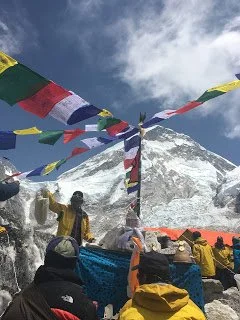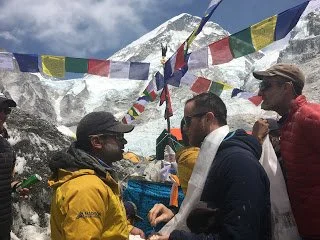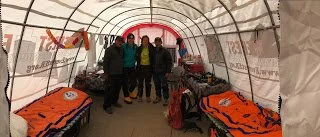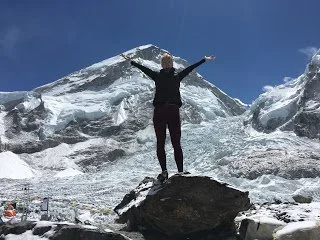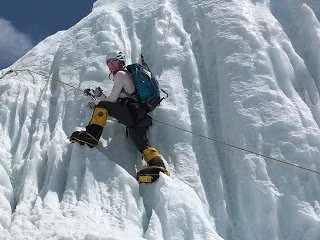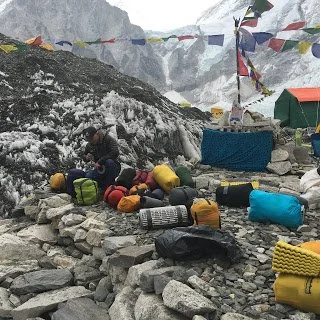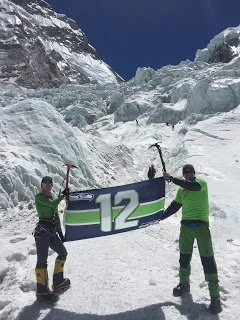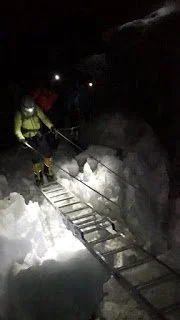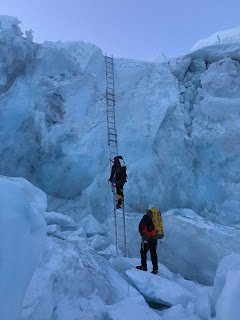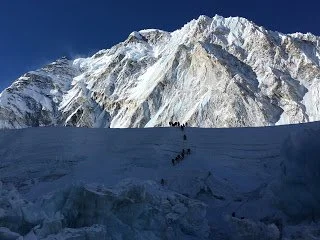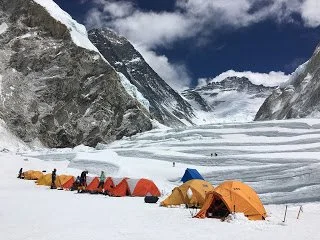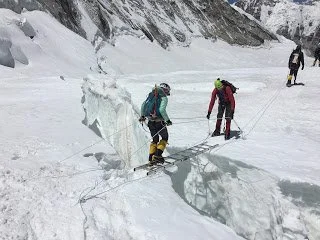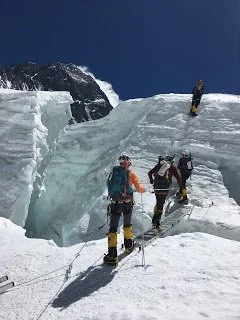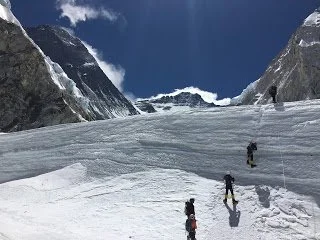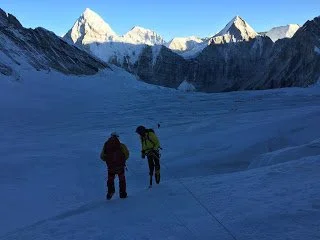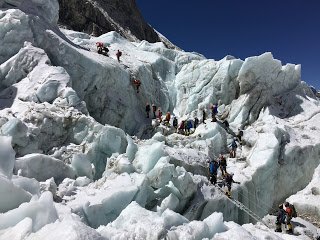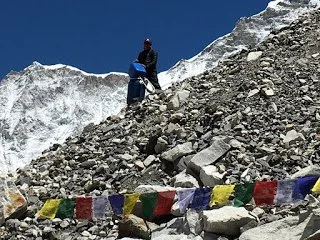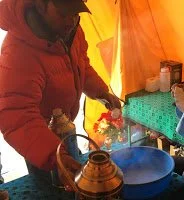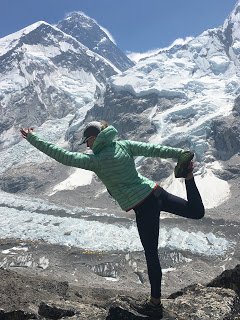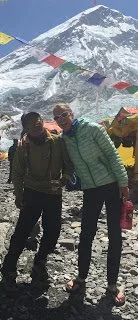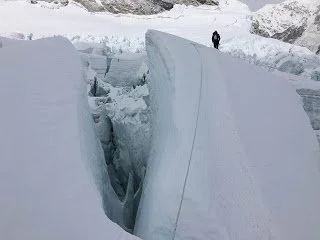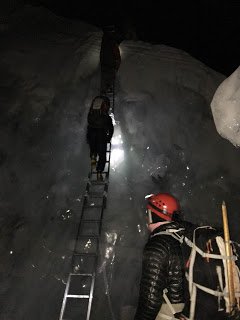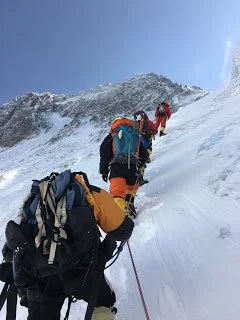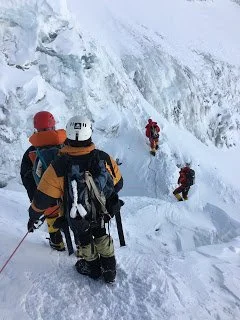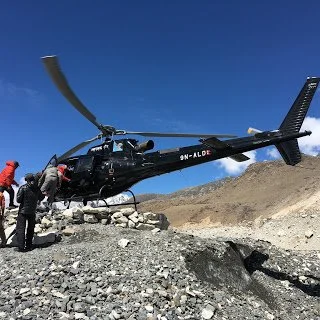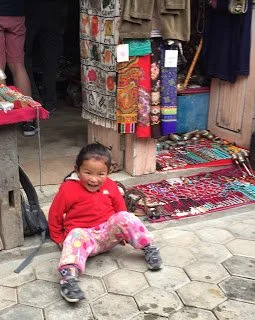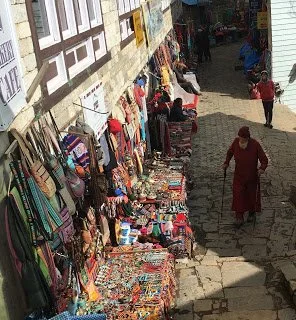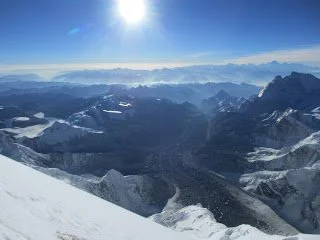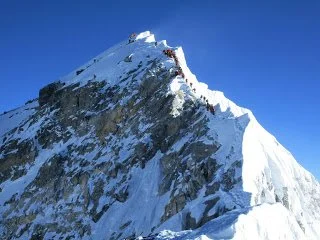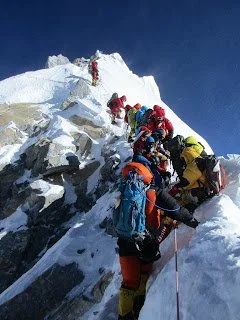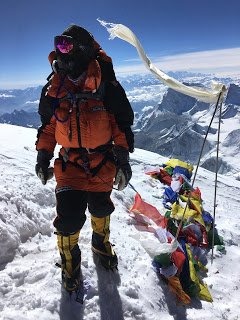Mount Everest
Nepal
29,035 feet ~ 8,848 meters
Overview
Unlike a lot of mountaineers, Mt. Everest wasn't at the top of my list of mountains to climb. While I expected that someday I would venture there, in the short term, I felt like there were more interesting mountains to climb.
After climbing in Nepal for the first time in the autumn of 2015, I knew that I needed to go back. There was something about the culture, and the people, and the endless snow-capped peaks that got to me. So, lacking endless time and resources, I decided to make Mt. Everest my next mountaineering objective.
Training Blog
Tuesday, March 22, 2016
This is a week of wrap-ups in preparation for Everest ... wrapping up projects and initiatives at work, finalizing gear lists and shopping, farewell dinners with friends ... but I am most excited that this evening was my last hypoxic workout!!
Hypoxic generator and mask ready for a run on the treadmill
While I appreciate the technology involved with generating air that contains less oxygen than atmospheric air, and am grateful for the acclimatization benefits that it gives me, hypoxic workouts are no treat, and I will not miss them.
The next time that I breathe anemic air, it will be for real!
Friday, March 25, 2016
Last Trail Run!
This evening I enjoyed my last trail run, just a short one to stretch my legs. My favorite trail is just a quick walk from my house. It is wooded, hilly, and secluded. In fact, in the hundreds of times that I have run on it, I have only seen one other person. Yet, my private trail is maintained, even decorated. All along it are odd shaped sticks, cairns, trinkets, memorials to pets, even tiny wind chimes. And tonight I was treated to this lovely bench.
I don't know who put it there, but it seemed like a good reason to take a minute to stop and contemplate the adventure that I am about to begin and all of the hard work that has gotten me to this point. I can't wait to get started. #everest2016
The Climb
Climbing Schedule with Madison Mountaineering:
Day 28: Climb to Camp 1
Day 29: Climb to Camp 2
Day 30: Rest in Camp 2, acclimatization hike on West shoulder
Day 31: Climb up Lhotse face to lower Camp 3, return to Camp 2 and sleep.
Day 32: Descend to base camp.
Day 33: Descend to Dingboche
Day 34-38: Rest in Dingboche, evaluate weather for summit window.
Day 39: Trek to Lobuche
Day 40: Trek to Everest base camp
Day 41: Climb to Camp 1
Day 42: Climb to Camp 2
Day 43: Rest in Camp 2
Day 44: Climb to Camp 3 (begin using Oxygen from Camp 2 on this morning)
Day 45: Climb to Camp 4
Day 46: Rest in Camp 4 or climb to Balcony
Day 47: Summit day and return to Camp 4
Day 48: Descend to Camp 2
Day 49: Descend to Everest base camp
Day 50: Helicopter out (at an additional cost) or trek to Dingboche
Day 51: Trek to Namche
Day 52: Trek to Lukla
Day 53: Fly Lukla to KTM
Day 54: Depart KTM for home
Days 55-60: Extra contingency days for bad weather, etc.
Days 61-62: Departure date for flights: May 31 from Kathmandu and June 1 return to home country.
Day 0: March 31st or April 1: Depart for Kathmandu.
Day 1: April 2: Arrive in Kathmandu (stay in Yak & Yeti hotel or equivalent)
Day 2: Equipment check and welcome dinner (stay in Yak & Yeti hotel or equivalent)
Day 3: Fly to Lukla by fixed wing aircraft (helicopter option available at an additional cost), trek to Phakding.
Day 4: Trek to Namche
Day 5: Rest in Namche, acclimatization hike to Everest view hotel
Day 6: Trek to Debuche
Day 7: Trek to Dingboche (visit with Lama Geshe in Pangboche this day)
Day 8: Rest in Dingboche, acclimatization hike
Day 9: Trek to Lobuche
Day 10: Trek to Gorak Shep
Day 11: Trek to Everest base camp
Day 12: Rest in base camp and organize equipment
Days 13-16: Train in lower Khumbu glacier (practice using fixed lines and crossing ladders, etc. each day for ½ day.
Day 16: Climb partway up Icefall (1/3) and return to base camp
Day 17: Climb to Camp 1, spend the night.
Day 18: Climb part way to Camp 2, return to Camp 1 to spend the night.
Day 19: Climb to Camp 2.
Day 20: Hike partway toward Lhotse face and return to Camp 2, spend the night.
Day 21: Descend to Everest base camp, spend the night.
Day 22: Descend to Dingboche
Day 23-25: Rest in Dingboche
Day 26: Trek to Lobuche
Day 27: Trek to Everest base camp
Wednesday, April 6, 2016
Namche Bazaar
I've safely arrived at Namche Bazaar! Not only is Namche the trading hub of the Khumbu region; it also serves as the gateway to the Himalaya as most climbers and trekkers heading to Everest base camp pass through it. To support the tourism business, the local Sherpa people own lodges, shops, and tea houses that cater to climbers and trekkers. In Namche you can drink a beer at an Irish pub and buy nearly everything necessary to outfit an expedition.
This is my first visit to Namche, and the narrow, cobbled streets seem busy to me, but one shop owner estimated 50% fewer customers this year, a sign that people are waiting to see what transpires during the 2016 Everest climbing season. Although it is unfortunate for the people making a living in the Khumbu, I’m happy to know that there will be fewer climbers on the mountain this year.
The next week is all about acclimatization as we slowly make our way from our current elevation of 11,300 feet to 17,500 feet at base camp. To aid in that process, today we hiked to the Everest View Hotel where I got my first view of Everest. It still seems impossibly massive and really far away.
Tomorrow we will leave the luxuries of hot showers, bakeries and electric blankets and trek to the village of Debuche, which is about 10 miles up the valley. So far I’m feeling good an am really excited to be starting this adventure!
Thursday, April 7, 2016
What an eventful day!
After breakfast at the Panorama Lodge we were treated to katas and good wishes from the proprietor, Sharip, and his family. We each took turns sipping homemade change, the local brew, while Sharip tied a silk kata around our necks and wished us safe passage on Mt. Everest.
Next our bags were loaded onto dzos, the half-cow half-yak animals that are used to carry loads at lower elevations in the Himalaya.
At 9am we hit the trail, headed for the village of Tengboche. We gradually gained and lost elevation multiple times, following the Dudh Koshi river. We spent most of the day on dusty, rocky, forested trails, shaded by pine trees and giant pink rhododendron. Ama Dablam, Everest, and Lhotse greeted us when the trail meandered out of the forest.
After several hours and a final steep push, we arrived at the Tengboche monastery and waited until 4 pm to view the lama’s daily prayer. A giant Buddha overlooked the room, and we crowded onto the wooden floor as the lamas each sat at their assigned spot on raised benches. They each put on a thick russet-colored robes before sitting cross-legged on their benches. After burning juniper, in unison, they chanted as they turned the pages fragile pages of their prayer books. It was a very moving experience.
We ended the day in Deboche and are now about half way on our forty-mile trek from Lukla to Base camp and each day Mt. Everest looks just a little bit closer :)
Friday, April 8, 2016
We left Deboche early this morning, crossed the Imja Khola river and began trekking toward Dingbouche.
Along the way we stopped at Lama Geshe's house in Pangboche to receive a blessing. The Lama, who appeared to be in his 90s, traditionally blesses all Himalayan climbers; one wall of his room is dedicated to summit photos. We crowded into one room of the Lama's house and waited while he finished blessing prayer flags for a local woman. Next, there was some discussion in Nepali between our Sherpa and the Lama and then various items for the blessing were collected - rice and special threads. Finally Lama Geshe started chanting and tossing rice in the air in all directions. After several minutes he lead us in chanting om ma ni pad me hung hri several times.
Lama Geshe told us the importance of giving up intentions to harm others and to do our best to benefit from all experiences.
The ceremony ended with each of us presenting the Lama with a kata which he blessed and then tied a string around our necks so that we will have a safe expedition.
Saturday, April 9, 2016
Today was a rest day in Dingboche, which doesn’t actually mean that I did any resting. Rather, the team hiked from town to Nangkar Tchang, the hike ended on a rocky outcrop at 16,200 feet, higher than any place in the continental US.
A rest day does mean that we will spend one more night in Dingboche which affords me the time to do some much needed laundry and to wash the dirt out of my hair. As we move closer to Everest base camp, services naturally become more sparse and more expensive. I splurged and spent 500 rupees (about $5) for a proper shower, as opposed to a five gallon bucket of hot-ish water for 300 rupees. While I waited for my turn in the shower - a yak had kicked the pipe requiring a repair - I sat on a stone bench and spoke to Chhiring, the proprietor of the Yak Lodge that I'm staying at. Chhring has attempted Everest nine times and now owns multiple lodges in the Khumbu. He told me that summiting Everest is "very easy", and advised me to breathe every time I take a step and not to "pant like a dog".
Most of the villages along our trek end in “buche” or “bouche”, which signifies that Buddha walked through them many, many, many years ago. Tomorrow we will move to Lobuche, our second-to-last stop before base camp.
Tuesday, April 12, 2016
I’ve arrived at Everest Base Camp!! It would not be possible for me to make the 40-mile journey from Lukla to EBC without the support of local porters, yaks, and dzos. Well, maybe it would be possible, but it would take a whole lot longer and I would be a lot less happy!
I am always a little torn about using porters and pack animals to carry my gear and supplies because part of me feels like it should be my responsibility. But, I also realize that supporting Himalayan climbers and trekkers provides a major boost to the Nepalese economy. In the 1950s, one-third of the Nepalese workforce was dedicated to portering. I am always humbled by the strength of the porters in the Himalaya, who are about the same stature as me and are able to carry incredibly heavy loads over precarious terrain; usually wearing sparse footwear.
The team will spend the rest of the day getting settled into our accommodations at EBC. In addition to our personal sleeping tents, our camp includes a communications tent, dining tent, cooking tent, shower tent, toilet tents, plus tents and facilities for our Sherpa team.
Wednesday, April 13, 2016
We enjoyed a beautiful, sunny day at Everest base camp today, which was perfect for our puja. A puja is a Buddhist ceremony which includes prayer, chanting, dancing, drinking, and making offerings. In our case, the offerings were made to Mt. Everest. The Nepali refer to the mountain as Sagarmatha or “Mother of the Universe”. Today we offered her fried dough, beer, yak milk butter, candy, and whiskey. If I were a deity, those are the offerings that I would appreciate :)
The ceremony begins by burning juniper on a stone alter. Then, the Lama chants, and intermittently throws rice in the air while blessing the climbers ice axes, crampons, and other gear. The high point of our two-hour ceremony was raising prayer flags over camp.
After the prayer flags were in place, we each received a kata and string from the Lama and we took turns wishing each other good luck and long life by wiping sampa (flour) on one another's cheeks.
The puja is done to ask for good fortune and safe climbing for the Sherpa and climbers and is especially important for the Sherpa because now they can begin climbing in order to prepare the mountain for us to safely climb.
Thursday, April 14, 2016
Today we took advantage of the morning sunshine to tour base camp. There are about 1000 people here, with 235 registered climbers for Everest or neighboring Lhotse as of the last count. In 2015 about 360 people were registered to climb either Everest of Lhotse. Needless to say, base camp is not as busy as typical years, and Everest veterans report that it is much more spread out.
Our tour included a stop at the Himalayan Rescue Association which functions as the Emergency Department for the mountain. Each expedition pays a fee for the support of its international volunteers. In exchange, consultations are free, and medications are dispensed at cost. The HRA also provides free medical care to Sherpa. The medical staff most frequently treats GI and respiratory issues, including the Khumbu cough. Ankle and wrist injuries are also common as walking on the ice/rock/yak poop terrain around base camp can be challenging.
This afternoon we will suit up in our climbing gear and venture out onto the ice for a short walk!
Saturday, April 16, 2016
The first significant obstacle on the journey to the summit of Mt. Everest will be the Khumbu icefall, which, even though I have been staring at it for five days, still looks impossibly daunting.
To be sure that we are prepared to safely and efficiently climb through the icefall, the Madison Mountaineering team will spend three days training in the lower icefall, just a short walk from our camp. We have spent several hours each morning working through obstacle courses of steep ice, ladders, and precarious ridges. The obstacles are both fun and exhausting, and already I feel more comfortable with the required skills.
Tomorrow we will continue our training and plan to begin climbing in the icefall on the 19th.
Cheers!
Monday, April 18, 2016
Today was a rest day for all of base camp. To show respect and remembrance for the 16 Sherpa who died in an avalanche when a serac fell off of Everest's west shoulder two years ago today.
For me, today was also an opportunity to reflect on the seriousness of this endeavor and to appreciate the Sherpa who make it possible for me to safely climb Everest. Mountains are fickle and unyielding, and don’t care if I have spent months preparing to climb them. They are in control, and I feel grateful everyday that I am able to safely climb. I also realize that I would not be able to climb Everest without the Sherpa who graciously support me and the rest of my team. Without fail, every Sherpa that I have climbed with is adept, unbelievably strong and respectful of the mountain. And also better at card games than they admit ;)
This afternoon the team prepared loads for our move to camp 1 on the 20th. The whole camp is excited and ready to begin climbing!
Tuesday, April 19, 2016
Today was all about preparing to move up the mountain! To increase the team’s comfort level with the Khumbu icefall, we ventured into it this morning. The terrain started out rocky, and I moved along clumsily in stiff mountaineering boots. Soon the rocks gave way to snow, and then to ice and all around me were towers of ice the size of buildings. We walked in the icefall for less than an hour, just until the ice got really steep.
We did take the time to find a safe spot to celebrate the Seahawks!
The Madison Mountaineering team will wake up at 1 am (ugh!), eat an early breakfast and leave base camp by 2:30 in order to make it to camp 1 before the heat of the day makes the icefall less stable. I am anticipating that it will take 6 - 8 hours to travel the 3.75 miles and 1900 vertical feet to camp 1, which sits at 19,390 feet. The plan - weather permitting - is to spend two nights at camp 1, then move to camp 2 (21,998 feet) and spend at least one more night there before returning to base camp to recover. The weather at this point looks good, so I am planning to spend 4 - 5 days on the mountain.
Look for an update when I return. Until then, you can find updates here.
Let the climbing begin!!
April 20, 2016
Climbing from base camp to camp 1. Two-thirty came early, but I was still excited to begin climbing. Base camp is comfortable, but it's a long way from the summit. I've always liked climbing in the dark because it's easy for me to focus on the circle of light coming from my headlamp and block every thing else out of my mind. It was hard to ignore; though, the seriousness of climbing through the Khumbu icefall. Occasionally I would hear a loud pop! as the ice continued to harden and crack in the cold night. There were several climbers and Sherpa starting out at the same time and for a while it felt like rush hour traffic as everyone vied for their place, based on their pace. A nearly full moon shone over me as I climbed up, over, and around towering blocks of ice. Just as the sun was rising, I heard a collapse of ice, but couldn't identify its location. My rule of thumb is that if I can feel the ice moving, I'm in trouble, but f I can only hear it I'm ok. I don't know if this is logical or not, but so far it has worked for me. When I heard the collapse I grabbed my Sherpa partner, Purba Rita and I think that I screamed right in his ear. We weren't in any danger, but it was still terrifying.
The rest of the morning continued basically the same way, climbing around and over unimaginably huge blocks of ice, which made me feel very small and very fragile. Near the end of icefall it was obvious that a collapse had occurred as the rope was buried, in this location ice chunks towered at least forty feet above me, and all I thought was that I wanted to get out of there as fast as my lungs and legs would allow.
April 21 camp 1 19,500 feet
My oxygen saturation yesterday afternoon, after I had been at camp 1 (19,600) feet was 75 percent. This afternoon it is 79 percent, a welcome improvement, but a saturation that low would earn me a trip to the Emergency Department if I were at home. I am always amazed by what our bodies can endure. Everything at altitude is more difficult. I loose my breath while drinking out of a water bottle, it takes extra effort just to put my boots on. And I have 9,500 feet to go! Needless to say, most of my time at the higher camps is spent relaxing in the tent, letting my body adjust to the new altitude by building more red blood cells, sleeping, reading, maybe playing cards if enough people have the energy.
The Madison Mountaineering team did spend a few hours this morning checking out the route to camp 2, we walked about a quarter of the way there - the most challenging part as the terrain is heavily crevassed and undulating and includes a few short, steep climbs and ladder crossings. We'll spend the rest of the day relaxing and then will move to camp 2 tomorrow!
Monday, April 25, 2016
Camp 2 21,300 feet
The wind roared all night at camp 1, when it whipped the nylon sides of the tent, a flurry of ice crystals fell on my face. Finding enough motivation to unzip my warm sleeping bag in the morning was challenging, and when I finally did the bottom of it was covered in a thin layer of snow that must have blown I through the vented tent door. Even though it is easy to forgo things like teeth brushing and deodorant, I think k it's important to keep up these rituals in order to feel just a little bit human. So, I forced myself through the motions and tried to ignore the wind and the upcoming project of going to the bathroom.
By 9:30 the team was geared up, fed, and ready to move up the glacier to camp 2. The first part of the route is a series of giant undulating crevasses that vary in depth from 10 to 25 feet, I'd guess. Multiple times we walked down one side, into the flat bottom, and jumared up the other side. The jumaring left me breathless for several minutes and I was thankful when the crevasses were skinnier and could be scaled by walking across a ladder. After this the terrain gave way to a mellow incline as we walked through the western cwm, boardered by Nuptse to the right, Everest's windy summit to the left, and the glistening blue ice of the Lhotse face in front of us. I tried not to think about ascending the steep face.
After about 3 hours we made it to the lateral moraine of Everest's west shoulder, which is home to camp 2. The 30 minute walk to camp was the hardest for me, my lungs screaming and struggling to function at 21,300 feet. I found an unfortunate distraction in the debris littering camp 2 - jars of peanut butter, tattered down clothing, kitchen strainers, nylon pieces of tents, entire kitchen kits. After last year's earthquake, camp 2 was evacuated very quickly, its inhabitants leaving behind most of their gear in an effort to quickly return to safety.
Camp 2 serves as Madison Mountaineering's advance base camp (ABC) we will stay here for three nights, and acclimatize by taking short walks on the glacier and moraine.
Tuesday, April 26, 2016
Back at base camp - first rotation complete!
The process of summitting Everest involves making multiple rotations from base to higher camps on the mountain. This process allows climbers to acclimatize to increasingly higher elevations, and to stock camps with food, gear, and fuel. The Madison Mountaineering team’s plan is to make three rotations, the third being a summit attempt.
So, the first rotation is complete! The team returned to base camp early this morning, leaving camp 2 (21,300 feet) at 5 am, just as the horizon was turning pale shades of purple and pink. It was cold, and a little windy and my crampons sounded like they were puncturing styrofoam on the descent from camp 2 to camp 1. The terrain was mellow, so I was able to watch the sun light pristine peaks in the distance and was grateful for the amazing parts of the world that climbing affords me to witness.
Although there were several queues of climbers to negotiate, the day continued smoothly, with a brief stop at camp 1 and then a safe descent through the Khumbu icefall.
The plan is to rest at base camp for several days, allowing our bodies to recover and build gazillions of red blood cells before starting the next rotation.
Wednesday, April 27, 2016
There are always things to do around camp, and today’s sunny skies afforded the whole team an opportunity to catch up on chores.
Everyday, the kitchen team works tirelessly to provide the climbers & Sherpa with not only surprisingly delicious food, but also clean water. At least a dozen times per day very strong Sherpa hike 10 minutes to a clean water supply, fill a 5-gallon jug, and carry it back to camp. I can hardly walk up the stairs to the dining tent without being out of breath!
Next, the water is boiled - just to be certain that it is clean, and finally, the tatopani (hot water) is strained into jugs for drinking. Chisopani (cold water) is also available, and just to be sure that it is safe to drink, I treat it with UV.
We are very fortunate to have hot showers, which involve carrying another heavy jug of water up a rocky hill, where it is dumped into a larger drum and thanks to the benefit of gravity, flows down downhill to the shower tent where it is heated by propane before flowing through the shower head. Although rustic - this is one of the best showers I have ever had!
Finally, since all of base camp is built on rock and ice, regular maintenance is required as the ice melts. This afternoon, my tent was on the verge of sliding down a rocky precipice, so the team re-built its foundation. Think about shoveling rock at 17,500 feet when you’re having a hard day at work!
Watching how hard our Sherpa team works to make our expedition safe and comfortable is completely humbling to me, these men work tirelessly, and always with good humor. Witnessing their labor makes me appreciate things like a warm shower and clean water. And, if it were not for their efforts, climbing in the Himalaya would be a very different - and more difficult experience for people like me.
Namaste!
Friday, April 29, 2016
The rest period between our first and second rotations is near it’s end! While the Madison Mountaineering team has technically been resting at base camp, we haven’t been bored, we’ve occupied ourselves in the following ways:
• EATING! (the strongest climber is the best eater ;)
• playing cards
• watching movies
• doing laundry
• generally making fun of each other
• daily “sancho” steams to keep our airways healthy
• socializing with other teams
• repairing gear
And, taking short hikes around base camp. Yesterday part of the team hiked to the base camp of neighboring Pumori, and enjoyed spectacular views of all of base camp.
Today, a few of us hiked about 1,000 feet above base camp to a rocky peak. It felt good to walk on dirt and see plants, and even bugs! A nice break from base camp’s rock and ice. I even took the opportunity to test my balance with a yoga pose!
If the weather and mountain allow, the plan is to begin our second rotation early (like, really early) on the morning of May 1st. This rotation will take us to camp 2 for a night (21,300 feet), then to camp 3 (24,000 feet) for a few hours before returning to camp 2 to spend a night or two.
Namaste!
Saturday, April 30, 2016
Time for the second rotation!
The weather and route look stable - thankfully the winds have abated - so in less than 12 hours the Madison Mountaineering team will depart base camp for camp 2 (21,300 feet). We are planning to spend the night of May 1st at camp 2, rest there the following day, then climb part way up the icy Lhotse face to camp 3 (24,000 feet), and spend a little time there to aid the acclimatization process before returning to camp 2 to spend one more night. The following morning we will return to base camp to recover.
These rotations are much easier for me thanks to my Sherpa partner, Purba, who assures that my hypoxic brain doesn’t make mistakes on the technical sections of the route. He also shoulders much of the responsibility for carrying my gear from camp to camp. His strength and endurance amazes me; he is 59 years old and smaller than me (I can usually only say that about teenagers). He has summited Everest 10 times and is a Lama, it makes me feel better that he wears prayer beads when he climbs :)
Fingers crossed for good weather and route conditions! For the next few days you can follow along here.
Namaste!
May 2 - Camp 2
The climb from base camp to camp 2 yesterday was challenging, although the terrain was now familiar to me, ten hours of climbing coupled with an unexpected snow storm was exhausting! It was much harder than I expected, I was grateful for the Sherpa that met me and Purba an hour outside of camp to share warm milk tea - just what I needed for the final push up the rocky moraine to camp!
It's now 5:00 pm on May 2nd, I'm laying in my tent at camp 2, trying to remember to breathe, drink, and eat.
I take short naps and then wake up, roll over, reluctantly unzip my sleeping bag, let the cold, dry air hit my face and lungs, and then breathe, drink, and eat a handful or M&Ms. At sea level I wouldn't have to remind myself to do these things, especially the eating M&Ms part, but at 21,300 feet everything is a chore. Outside I hear snow softly hitting my tent. It's small pellets of snow, confirming that the temperature is probably below zero. Every few minutes small piles of it slide down the nylon sides of the tent and I am worried that there will be too much unconsolidated snow to safely climb the steep Lhotse face tomorrow morning. The plan is to climb to camp 3 (23,000 feet) to get familiar with moving up the face efficiently and safely and to dial in the equipment that will keep us warm and safe - down suits and mits, electronic foot warmers, ascenders. Although tomorrow will be a tough day - 6 hours of climbing straight up - I'm hopeful that the weather cooperates because it will be important for building confidence for my summit attempt in a few weeks.
May 3 - Camp 3
Today I learned that breathing at 23,000 feet is very difficult, especially while you're trying to climb straight up snow and ice.
The team left camp 2 at 6 am, bundled in layers of down and well rested, ready for the challenge of the Lhotse face. We climbed pretty much straight up for about 5.5 hours until we reached camp 3, a collection of tents perched on the icy face.
When climbing on steep, monotonous terrain like this, it's easiest for me to find a rhythm, so I focused on taking one step per breath, and then sliding my ascender up the fixed line. Breathe - step - breathe - step - slide. Repeat.
We were all tired at camp 3, and we laid in the snow on the mountainside, bundled in down suits, meanwhile Sherpas from another team were digging tent platforms with a pick axe. I don't know how they do it. After about an hour, clouds started to move in, cutting our high altitude nap short, so the team descended the steep slope in arm wrap style (using a carabineer and rope attached to my harness, holding tension behind me while walking straight down the 40 degree slope (it's mostly terrifying)), with a few rappels, and returned safely to camp 2 just as it started to snow.
May 4 - Back at base camp!
The team left camp 2 early (6 am) yesterday morning. My motivation for getting up early was a shower and thick air ... and cake. We are now moving efficiently through the icefall, although I still don't like being there. The route changes slightly every time, a reminder that the ice is constantly moving. By noon I'd had my shower :) What a joy to be "shower clean", instead of baby powder - wet wipe - hand sanitizer "clean".
The Madison Mountaineering team is now resting in the luxury of base camp - comfy tents, Internet, and thick air (plus cake) - and making plans to do a "drop back" to a village at a lower elevation while we wait for the route to be fixed to the summit and for a good weather window. Descending to lower elevations for a few days will allow our bodies to recover from the stress of high elevation. Our oxygen saturations and appetites will improve and in general we'll feel like rock stars while we continue to mass produce red blood cells. Then, just before the summit push, we will return to base camp, rested, recovered, and ready for the summit!
Friday, May 6, 2016
I woke up this morning to the sound of a rock being banged against an empty metal gas cylinder … time to wake up … and fly to Namche!
Today the Madison Mountaineering team traveled by helicopter to Namche Bazzar, which is about 5,000 feet below base camp. We will spend 4 or 5 nights here in order to let our bodies recover from living at high altitude for the past month. The idea is that our bodies will be less stressed at 12,000 feet, our appetites will soar, and our sore muscles will recover, putting us in the best possible position for a successful summit.
As soon as I exited the helicopter in Namche, the thick air hit my lungs, even though I’m at 12,000 feet, it feels luxurious!
The risk of leaving base camp, where we are relatively segregated, is that we will catch a cold or bug in the busy tourist village of Namche. So, I am taking hand sanitizer everywhere that I go, not shaking hands with anyone, and breathing through a buff. Fingers crossed that it all works!
Saturday, May 7, 2016
A perfect day in Namche ... yoga, meditation, massage, dessert after every meal, and an Om mani padre hum stone.
The revised plan is to fly back to base camp tomorrow in order to begin climbing on the 10th and take advantage of a favorable forecast, which looks good until the 15th :)
Almost game time !!!
Sunday, May 8, 2016
Preparing for the summit rotation!
My backpack is nearly packed, I’ve spent most of the morning checking and re-checking gear and packing the essentials that I will need for the summit rotation - extra warm clothes, crampons, food (mostly sugar), a small supply of meds to manage my constant nasal congestion, chemical hand and foot warmers.
After months of thinking about and preparing for it, it’s time to climb to the summit! I feel 50% excited and 50% anxious, which is an improvement over yesterday when I was 75% anxious. I am keeping my mind focussed on what I need to accomplish each day, which helps me to not get overwhelmed.
Tonight, around midnight, the Madison Mountaineering team will depart for camp 2. I’ve climbed there twice already, so the terrain is familiar and, aside from spending hours in the shifty Khumbu icefall, I know what to expect.
The following day, the team will rest at camp 2, and the day after we will climb to camp 3, which is also familiar. After that, I’m stepping into the unknown … the next day the team will climb to camp 4, which is situated on the south col, and at 26,000 feet is the last stop before the summit. I’m feeling healthy and strong - although I can’t believe how much muscle I have lost in the past month! Plus, above camp 2 I will be using bottled oxygen, which will help to keep me warm and alert.
I know that the next week will present incredible challenges for me - mentally and physically - but I am confident that I have the skill and ability to overcome those challenges. I also realize that those challenges are not meant to stop me from reaching my goal, they are a part of the path to my goal.
I also feel incredibly grateful that I have even been afforded this opportunity, as there have been a lot of obstacles that threatened to prevent this climb for me.
All of the preparation is over, and there is just one thing left to do!
While I am on the mountain, you can find regular updates here.
Thursday, May 26, 2016
I laid in my shared tent on the evening of May 18th and tried to sleep, which was difficult given the cramped space, oxygen mask, and bulky down suit that I was wearing. The song Desperato from the Eagles kept running through my head for some reason. I didn’t feel nervous or unsure of my ability to successfully climb the 3,000 feet of snow, rock, and ice that separated me from the top of Everest … I just felt ready. I did sleep, eventually, and woke up when one of my tent mates shook me and sad “It’s time to climb to the top of the world”. I was nearly dressed, I just had to add boots and a climbing harness. Even so, this was an arduous task at 26,000 feet in a crowded tent. As I laced my boots I thought about the steps that had brought me to this point … my first summit of Mt. Rainier, annual trips to more remote locations to try my legs and lungs on tougher peaks, beating cancer just before my first attempt at a Himalayan peak, missed dinners with friends, early morning runs in the rain, leaving a career that I loved … I reminded myself that everything was meant to bring me to this moment. “There is just one thing left to do”, I thought and crawled out of the tent into the frigid night.
Aside from feeling like I was in rush hour traffic when I left camp 4 with my team, things started off smoothly as each climber jockeyed for his or her spot on the on the fixed rope. The night was crisp and beautiful. Countless stars pierced the dark sky, and the head lamps from climbers ahead of me created a chain of twinkling light, it looked like they were climbing right into the sky.
The long line of climbers that I was in moved slowly, so I took the opportunity to focus on taking care of myself by eating chocolate covered coffee beans and honey from the pocket of my down suit. This was a monumental task given the thick gloves and oxygen mask that I was wearing, but I was determined not to run out of fuel on this day. The toes of my right foot were starting to feel the effects of the cold night and I made frequent efforts to wiggle each toe to be certain that I could still feel it. I told myself that if I could no longer feel them, I would turn around.
Finally the sun started to color the horizon and relieved my concerns about getting too cold. I watched it slowly rise over my right shoulder, and eventually I could see Tibet, a giant glacier sliding through it.
To my left were the peaks of the Himalaya and the route that I had taken from base camp. Before I knew it I was staring up (straight up!) at the south summit, thankfully the crowds had dispersed at this point and I could climb at my own pace with my Sherpa partners. I thought about the terrain ahead …the south summit, the Hillary step, and the true summit … in the past year there had been countless obstacles between me and the summit of Everest, and now there were just two. I started to get emotional about that, but shifted my focus back to breathing and moving my feet. I wouldn’t let myself celebrate until I was safely back at base camp.
Unfortunately the crowds found me again on the southeast ridge, and I focussed on precise placement of my hands and cramponed feet. The ridge felt like a one-way street trying to accommodate two-way traffic.
Many, many times it was necessary to un-clip from the fixed line in order to move around fellow climbers who were descending. I noticed my breathing getting heavier from the fear of falling, and I focused on taking slow, steady breaths. These were “no mistake” moments.
At 8:10 there was no place else to climb. I was on top. Of the world.
I wish that I could say that the feeling was fantastically euphoric, that I felt enlightened. But I didn’t. My emotions were much more practical. I felt like I had a lot of descending to do, and I knew that negotiating the crowds on the descent would be physically challenging and mentally stressful. I felt like the wind was picking up and I didn’t want to get caught in an unpredicted storm.
I also felt thankful that several members of my team were on top with me, we had worked so hard together and bonded over the past two months, it would not have felt right to enjoy the summit without them.
After the requisite photos, I took a few moments to think about some of the people that helped me achieve my goal. Each person played a part, some big, some small, some probably didn’t even realize that they had made a positive impact. Like the girl that I met while training who hugged me and whispered “you got it, girl” after I explained to her why I was doing laps on Mt. Si.
It has been a week since I summited Everest, and I still believe that my accomplishment hasn’t really sunk in. People have asked me if I feel different, and I think that I probably do, I feel braver and stronger. I think about a favorite quote:
Promise me you'll always remember: you're braver than you believe, stronger than you seem, and smarter than you know ~A. A. Milne
I also feel hopeful and encouraged and more aware that the world is full of possibilities if we are just open to them.
People have also asked me what is next; it is true that normally I have chosen my next mountaineering objective before I have finished the current one. This time I don’t have an answer. I suspect that I will climb more 8,000 meter peaks, the idea of summiting and unclimbed peak is also appealing to me.
But first I am going to the beach :)





